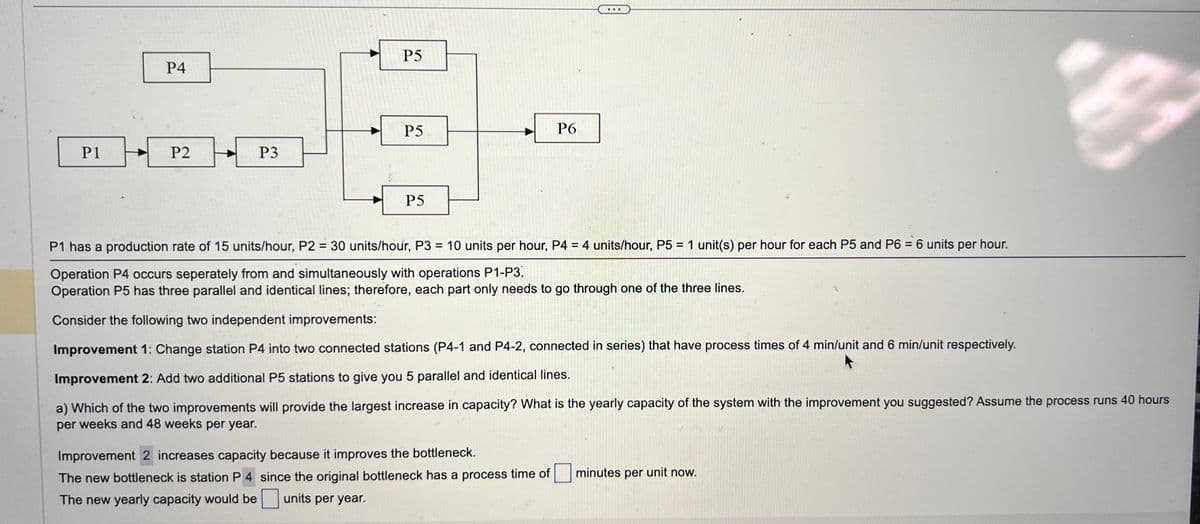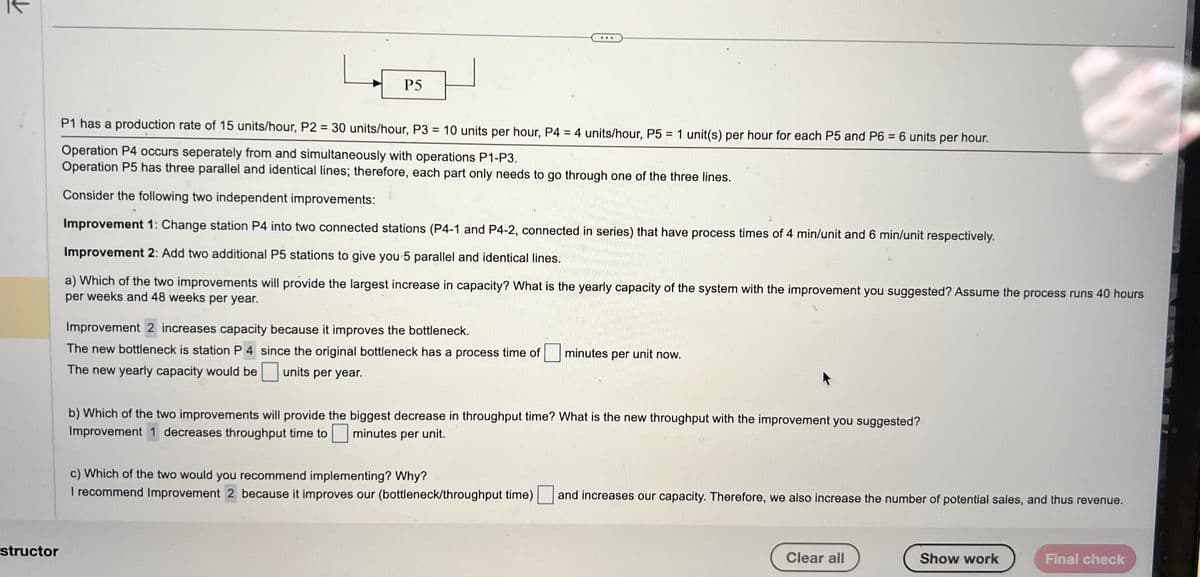P1 P4 + P2 → P3 P5 P5 P5 P6 B P1 has a production rate of 15 units/hour, P2 = 30 units/hour, P3 = 10 units per hour, P4 = 4 units/hour, P5 = 1 unit(s) per hour for each P5 and P6 = 6 units per hour. Operation P4 occurs seperately from and simultaneously with operations P1-P3. Operation P5 has three parallel and identical lines; therefore, each part only needs to go through one of the three lines. Consider the following two independent improvements: Improvement 1: Change station P4 into two connected stations (P4-1 and P4-2, connected in series) that have process times of 4 min/unit and 6 min/unit respectively. Improvement 2: Add two additional P5 stations to give you 5 parallel and identical lines. a) Which of the two improvements will provide the largest increase in capacity? What is the yearly capacity of the system with the improvement you suggested? Assume the process runs 40 hours
P1 P4 + P2 → P3 P5 P5 P5 P6 B P1 has a production rate of 15 units/hour, P2 = 30 units/hour, P3 = 10 units per hour, P4 = 4 units/hour, P5 = 1 unit(s) per hour for each P5 and P6 = 6 units per hour. Operation P4 occurs seperately from and simultaneously with operations P1-P3. Operation P5 has three parallel and identical lines; therefore, each part only needs to go through one of the three lines. Consider the following two independent improvements: Improvement 1: Change station P4 into two connected stations (P4-1 and P4-2, connected in series) that have process times of 4 min/unit and 6 min/unit respectively. Improvement 2: Add two additional P5 stations to give you 5 parallel and identical lines. a) Which of the two improvements will provide the largest increase in capacity? What is the yearly capacity of the system with the improvement you suggested? Assume the process runs 40 hours
Practical Management Science
6th Edition
ISBN:9781337406659
Author:WINSTON, Wayne L.
Publisher:WINSTON, Wayne L.
Chapter2: Introduction To Spreadsheet Modeling
Section: Chapter Questions
Problem 20P: Julie James is opening a lemonade stand. She believes the fixed cost per week of running the stand...
Related questions
Question

Transcribed Image Text:P1
P4
P2
P3
P5
P5
P5
P6
...
P1 has a production rate of 15 units/hour, P2 = 30 units/hour, P3 = 10 units per hour, P4 = 4 units/hour, P5 = 1 unit(s) per hour for each P5 and P6 = 6 units per hour.
Operation P4 occurs seperately from and simultaneously with operations P1-P3.
Operation P5 has three parallel and identical lines; therefore, each part only needs to go through one of the three lines.
Consider the following two independent improvements:
Improvement 1: Change station P4 into two connected stations (P4-1 and P4-2, connected in series) that have process times of 4 min/unit and 6 min/unit respectively.
Improvement 2: Add two additional P5 stations to give you 5 parallel and identical lines.
Improvement 2 increases capacity because it improves the bottleneck.
The new bottleneck is station P4 since the original bottleneck has a process time of
The new yearly capacity would be units per year.
a) Which of the two improvements will provide the largest increase in capacity? What is the yearly capacity of the system with the improvement you suggested? Assume the process runs 40 hours
per weeks and 48 weeks per year.
B
minutes per unit now.

Transcribed Image Text:↓
structor
P5
***
P1 has a production rate of 15 units/hour, P2 = 30 units/hour, P3= 10 units per hour, P4 = 4 units/hour, P5 = 1 unit(s) per hour for each P5 and P6 = 6 units per hour.
Operation P4 occurs seperately from and simultaneously with operations P1-P3.
Operation P5 has three parallel and identical lines; therefore, each part only needs to go through one of the three lines.
Consider the following two independent improvements:
Improvement 1: Change station P4 into two connected stations (P4-1 and P4-2, connected in series) that have process times of 4 min/unit and 6 min/unit respectively.
Improvement 2: Add two additional P5 stations to give you 5 parallel and identical lines.
a) Which of the two improvements will provide the largest increase in capacity? What is the yearly capacity of the system with the improvement you suggested? Assume the process runs 40 hours
per weeks and 48 weeks per year.
Improvement 2 increases capacity because it improves the bottleneck.
The new bottleneck is station P4 since the original bottleneck has a process time of
The new yearly capacity would be
units per year.
minutes per unit now.
b) Which of the two improvements will provide the biggest decrease in throughput time? What is the new throughput with the improvement you suggested?
Improvement 1 decreases throughput time to minutes per unit.
c) Which of the two would you recommend implementing? Why?
I recommend Improvement 2 because it improves our (bottleneck/throughput time) and increases our capacity. Therefore, we also increase the number of potential sales, and thus revenue.
Clear all
Show work
Final check
Expert Solution
This question has been solved!
Explore an expertly crafted, step-by-step solution for a thorough understanding of key concepts.
Step by step
Solved in 4 steps with 3 images

Recommended textbooks for you

Practical Management Science
Operations Management
ISBN:
9781337406659
Author:
WINSTON, Wayne L.
Publisher:
Cengage,

Operations Management
Operations Management
ISBN:
9781259667473
Author:
William J Stevenson
Publisher:
McGraw-Hill Education

Operations and Supply Chain Management (Mcgraw-hi…
Operations Management
ISBN:
9781259666100
Author:
F. Robert Jacobs, Richard B Chase
Publisher:
McGraw-Hill Education

Practical Management Science
Operations Management
ISBN:
9781337406659
Author:
WINSTON, Wayne L.
Publisher:
Cengage,

Operations Management
Operations Management
ISBN:
9781259667473
Author:
William J Stevenson
Publisher:
McGraw-Hill Education

Operations and Supply Chain Management (Mcgraw-hi…
Operations Management
ISBN:
9781259666100
Author:
F. Robert Jacobs, Richard B Chase
Publisher:
McGraw-Hill Education


Purchasing and Supply Chain Management
Operations Management
ISBN:
9781285869681
Author:
Robert M. Monczka, Robert B. Handfield, Larry C. Giunipero, James L. Patterson
Publisher:
Cengage Learning

Production and Operations Analysis, Seventh Editi…
Operations Management
ISBN:
9781478623069
Author:
Steven Nahmias, Tava Lennon Olsen
Publisher:
Waveland Press, Inc.